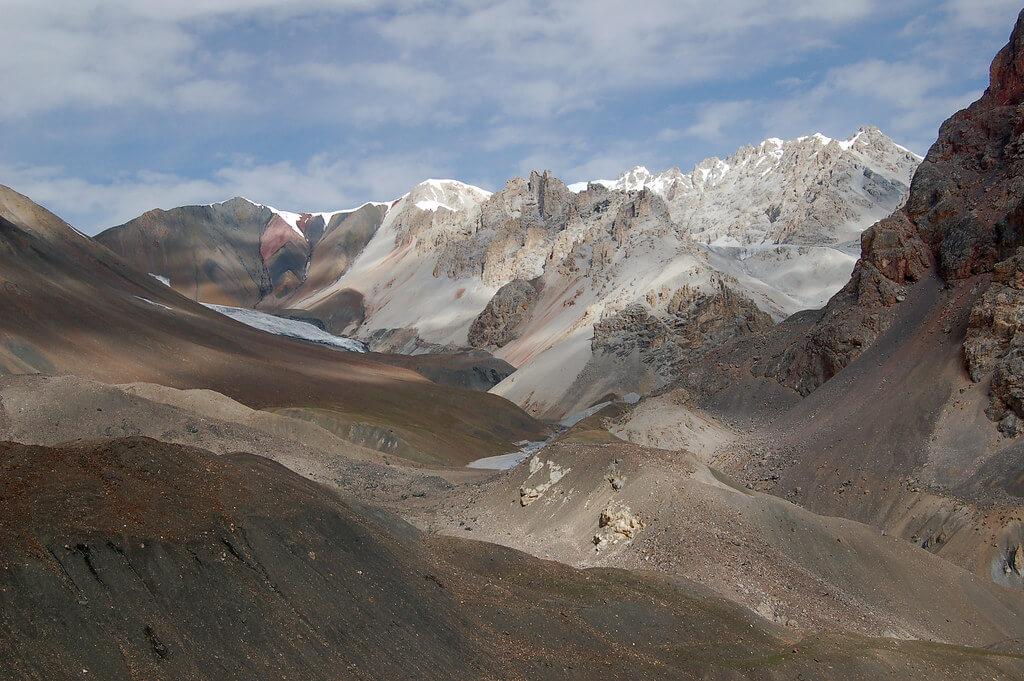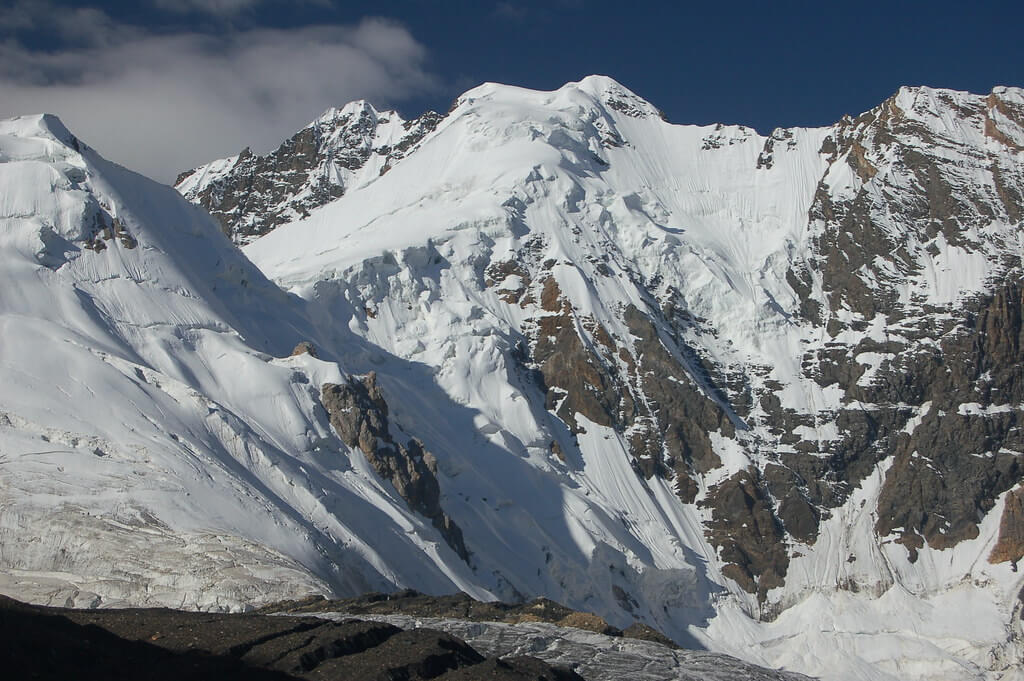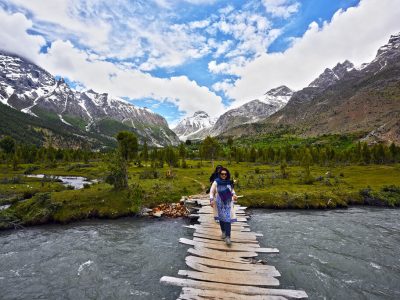Lupgar Pir Pass
The Lupgar Pir Pass, nestled among the lonely and awe-inspiring Karakoram mountain range, is a secret jewel that has long avoided the attention of trekkers and adventurers. This non-glaciated pass, at an elevation of 5190 meters, provides a journey unlike any other. It follows the southern edge of the Chapursan Valley, providing a critical link between the upper Chapursan Valley's Yishkuk and the steep, scenic Lupgar Valley's Raminj.
Itinerary
The Itinerary for the Lupgar Pir Pass is noticeable below
Day 02: Raud to Wyeen
Cross the clear stream and walk for five minutes along its true left bank to the two-part wooden footbridge that spans the enormous glacial torrent. Ascend 30 minutes above the river's true left bank via junipers on a tiny, clean herder's track to Kit-ke-zherav (3690m) huts and livestock pen. In five minutes, you may reach the little Kit-Ke-zherav stream from the south. Cross it and continue 45 minutes up the steep, rocky ablation valley to Shot Dur (3780m; 'avalanche valley'). This is the glacier's last source of water. Continue up the valley, ultimately climbing out of it to contour the green hillside, and in 45 minutes you'll reach a dark talus slope.
In 15 minutes, cross the greasy black talus known as Charva Shui (3990m). Return to the ablation valley, gradually climbing for 30 minutes until the valley turns south.
A side valley highlighted by red rock can be found over the Wyeen Glacier to the east. The grassy meadow seen between two tiny ridges to the south of it is Wyeen camp. The glacier can be crossed in two hours. The glacier's rock is mainly stable, and the crossing is simple. Continue to the north (left) of two massive white and brown debris mounds in the glacier's centre. Only one or two tents can be erected near to the cabins at Wyeen (4100m), with a couple more on rooftops. Larger trekking groups Camp along the glacier stream that flows from Banafshayeen. Clear water can be found right above the livestock pen.
Day 03: Wyeen to Haji Beg Camp
Cross directly to the true left bank of the Banafshayeen creek. Spend one hour climbing the lateral moraine of Wyeen Glacier on loose boulders. Walk along the stream's side after leaving the moraine. Just below the mouth of the Banafshayeen Valley (4200m), cross to its true left bank. A large trekking party could camp across the silty stream in an open location adjacent to a small moraine lake. Ascend the grassy slope to the level of Banafshayeen Valley (4410m) in 30 minutes. The vista of Kuk Sar (6943m) and its 3000m vertical face is spectacular. The highest pasture used by Wyeen herders is called Banafshayeen, which means "the place where banafsha (Primula macrophylla) grows."
There are no paths or cairns beyond this point. Continue gradually up the true right bank of the stream. The terminus of an unidentified glacier (4650m) that fills the valley is one hour above the Banafshayeen meadow. The Swiss map does not depict this glacier; instead, it shows two small glaciers higher up the valley. These glaciers have combined and descended to the point on the map where their outwash streams meet. Skirt the glacier well above its northern boundary. A 45-minute walk on the black lateral moraine to a little side valley with a clear stream. Continue high above the glacier for another hour to a second-side valley with a larger, pure stream pouring down. Ascend for five to ten minutes following this stream to a huge flat spot where the remains of a square enclosure close to a large, prominent boulder show that others had gone this way. Haji Beg Camp (4680m) was named by the authors in 1994 after their traveling companion who represents the essence of these mountains. The views are spectacular, and the pass can be seen from the head of this side valley.
Day 04: Haji Beg Camp to Wyeen
Follow the stream for one to two hours north-east to its head (5100m), then 30 minutes east-northeast up higher scree to the Lupgar Pir Pass (5190m). By mid-July, the pass is frequently snow-free. Beyond Kuk Sar to the southwest, Pamir Sar (7016m) is visible, which Schomberg characterized as a "series of superb peaks and glaciers."
Descend steep, loose scree to a scree knoll, then continue over the knoll to the left and down to a glacier. This 300m descent takes between 15 and 30 minutes. Take a zigzagging path out onto the white glacier to avoid crevasses. 30 minutes, work across and slightly down the glacier's 15- to 20-degree slope to a small black medial moraine. Continue on to the terminal moraine, which has a few pools. More pools can be seen about 500m below the glacier's snout. Rather than descending towards the river's mouth, keep high and walk right on scree, well above the river, for 30 minutes to a clear stream and another 15 minutes to Wyeen (4530m).
The upper Lupgar Valley is known for its dramatic red, yellow, and brown rock formations. Climbers may be interested in the valley's snowy 6000m peaks, which appear to be easy ascents.
Day 05: Wyeen to Hoopkerch
Drop down to the main river bed and follow a faint track. Reach the enormous outwash stream from the big glacier to the south in 15 minutes. It has a number of knee-deep waterways. Continue one hour across the creek to Ilga (4380m), a grassland with some unused houses. In the afternoon, the water from a hanging glacier is unusually silty. On the north side of the valley, there are beautiful snowcapped spires with scree flowing from their bases to the river. Fantastic red crags can be found on its south side.
Descend for 20 minutes to Ghorhil, a natural cattle corral (hil) in the midst of a boulder field (ghor). The water is muddy. Descend about 15 minutes among steep boulders to a river coming in from the south. Cross the river and proceed to Lupgar (4140m, 'great rock'), the principal summer village for Khaibar and Raminj herders who share grazing rights in this region. A little spring can be found at the base of a cliff to the south. When leaving Lupgar, stay close to the cliffs. 15 minutes from Lupgar, cross a southern side stream over a stone footbridge, then descend down its true right bank for 30 minutes to the Lupgar River. Two-thirds of the way down, on the left, is a massive spring with the last reliable clean water till Raminj.
Cross the river over an interesting footbridge and follow the trail along the true left bank past Khuda Khair Charjeshan, the ‘God assist us slides’. In wind or rain, rock fall along this area is hazardous, as the trail is incredibly narrow and exposed.
After 45 minutes, the walk reaches a natural footbridge. The gorge is so deep and narrow that the river below is invisible. Continue on a small, loose route with a challenging footbridge after crossing the true right bank. Continue down the valley, passing through two side creeks. The water in one is crimson, whereas the water in the other is pale. Descend for one hour to a sandy riverbank, going through a birch wood, then ascent and reach a juniper forest. Hoopkerch (3700m,' seven hunters' houses') is ahead and below 15 minutes, where a glacier side stream enters from the south. A little spring is located beneath the livestock fence.
Day 06: Hoopkerch to Raminj
Cross the muddy stream on a footbridge and proceed one hour through the lovely ancient juniper forest to Harkeesh (3489m, the 'place farmed with a plough'). Harkeesh is the valley's unique Burushaski place name, named by a Raminj Burusho who attempted to cultivate here. Harkeesh's Wakhi name is Kishtazod. The well-constructed cabin and livestock pen are surrounded by a large, open grassy space that is ideal for camping. The canyon walls ascend to cliffs that are crowned with massive, multicolored stone peaks, spires, and towers. The Werthum Pass route terminates here (see p). The water in the side stream may be silty. Descend sharply for 10 minutes from Harkeesh and cross a side brook via a footbridge. Birches, roses, tamarisks, and junipers thrive in Furzeen (Purzin on the Swiss map). Cross a strong footbridge to the Lupgar River's left bank in five minutes. The trail from here to Raminj is much better, albeit it remains exposed in spots. The trail goes high above the river gorge for the following 114 to 112 hours until the Raminj canal's headworks, occasionally lowering closer to the river. Midway, cross a footbridge to the real right bank of the Lupgar River above the confluence of the Lupgar and Dior rivers, which leads to the Dior hut. Follow the willow-lined canal for one hour to Raminj, passing various gushing springs along the way. The canal, constructed during Mir Muhammad Jamal Khan's rule and completed in 1978, is a wonder of engineering. Several tunnels dug into the rock transport the canal beneath the scree slopes that the path traverses. Raminj (3095m), located at the confluence of the Lupgar and Chapursan rivers, is a lovely, well-kept town with east and south exposures.
Holiday Overview
For years, the local communities in this region have used these valleys primarily for cattle grazing rather than traversing the past. This path did not re-enter the realm of exploration until 1994, indicating a "reopening" of sorts. The current crossing in 1994 followed in the footsteps of Schomberg's 1934 expedition, rekindling the pass's fascination for trekkers and mountaineers alike.
Lupgar Pir Pass offers daring travelers to traverse this spectacular terrain, with two unique routes available. Because Yishkuk is 300 meters higher than Raminj, the west-to-east approach provides for a more progressive acclimatization procedure. Furthermore, the west side of the pass has a shorter and less scree-laden ascent than the east. The non-technical glacier traverses on this route give an element of adrenaline and difficulty for those who dare to embark on this expedition.
Lupgar Pir Pass is a monument to the Karakoram's enduring fascination, an invitation to explore its untamed landscapes and cultural complexities. It is still a hidden treasure, ready to be discovered by people seeking the unspoiled beauty and unexplored experiences that the mountains have to offer. Its attractiveness grows with each passing year, solidifying its standing as a must-see destination for travelers seeking the thrill of the unknown.



